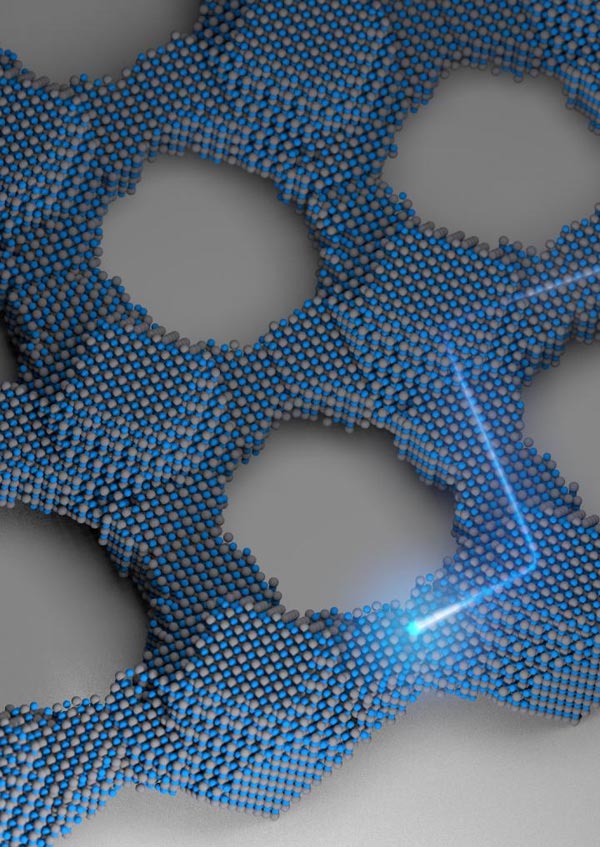Quantum dot solids: This generation's silicon wafer?

Connecting the dots: Playing 'LEGO' at the atomic scale to build atomically coherent quantum dot solids. Credit: Kevin Whitham, Cornell University
The team, led by Tobias Hanrath, associate professor in the Robert Frederick Smith School of Chemical and Biomolecular Engineering, and graduate student Kevin Whitham, has fashioned two-dimensional superstructures out of single-crystal building blocks. Through a pair of chemical processes, the lead-selenium nanocrystals are synthesized into larger crystals, then fused together to form atomically coherent square superlattices.
The difference between these and previous crystalline structures is the atomic coherence of each 5-nanometer crystal (a nanometer is one-billionth of a meter). They're not connected by a substance between each crystal – they're connected to each other. The electrical properties of these superstructures potentially are superior to existing semiconductor nanocrystals, with anticipated applications in energy absorption and light emission.
“As far as level of perfection, in terms of making the building blocks and connecting them into these superstructures, that is probably as far as you can push it,” Hanrath said, referring to the atomic-scale precision of the process.
The Hanrath group's paper, “Charge transport and localization in atomically coherent quantum dot solids,” is published in this month's issue of Nature Materials.
This latest work has grown out of previous published research by the Hanrath group, including a 2013 paper published in Nano Letters that reported a new approach to connecting quantum dots through controlled displacement of a connector molecule, called a ligand. That paper referred to “connecting the dots” – i.e. electronically coupling each quantum dot – as being one of the most persistent hurdles to be overcome.
That barrier seems to have been cleared with this new research. The strong coupling of the nanocrystals leads to formation of energy bands that can be manipulated based on the crystals' makeup, and could be the first step toward discovering and developing other artificial materials with controllable electronic structure.
Still, Whitham said, more work must be done to bring the group's work from the lab to society. The structure of the Hanrath group's superlattice, while superior to ligand-connected nanocrystal solids, still has multiple sources of disorder due to the fact that all nanocrystals are not identical. This creates defects, which limit electron wave function.
“I see this paper as sort of a challenge for other researchers to take this to another level,” Whitham said. “This is as far as we know how to push it now, but if someone were to come up with some technology, some chemistry, to provide another leap forward, this is sort of challenging other people to say, 'How can we do this better?'”
Hanrath said the discovery can be viewed in one of two ways, depending on whether you see the glass as half empty or half full.
“It's the equivalent of saying, 'Now we've made a really large single-crystal wafer of silicon, and you can do good things with it,'” he said, referencing the game-changing communications discovery of the 1950s. “That's the good part, but the potentially bad part of it is, we now have a better understanding that if you wanted to improve on our results, those challenges are going to be really, really difficult.”
###
This work made use of the Cornell Center for Materials Research, which is supported by the National Science Foundation through its Materials Research Science and Engineering Center program. X-ray scattering was conducted at the Cornell High Energy Synchrotron Source, which is supported by the NSF and the National Institutes of Health.
Media Contact
All latest news from the category: Materials Sciences
Materials management deals with the research, development, manufacturing and processing of raw and industrial materials. Key aspects here are biological and medical issues, which play an increasingly important role in this field.
innovations-report offers in-depth articles related to the development and application of materials and the structure and properties of new materials.
Newest articles

A ‘language’ for ML models to predict nanopore properties
A large number of 2D materials like graphene can have nanopores – small holes formed by missing atoms through which foreign substances can pass. The properties of these nanopores dictate many…

Clinically validated, wearable ultrasound patch
… for continuous blood pressure monitoring. A team of researchers at the University of California San Diego has developed a new and improved wearable ultrasound patch for continuous and noninvasive…

A new puzzle piece for string theory research
Dr. Ksenia Fedosova from the Cluster of Excellence Mathematics Münster, along with an international research team, has proven a conjecture in string theory that physicists had proposed regarding certain equations….



